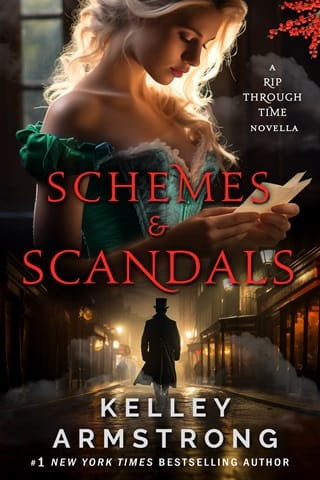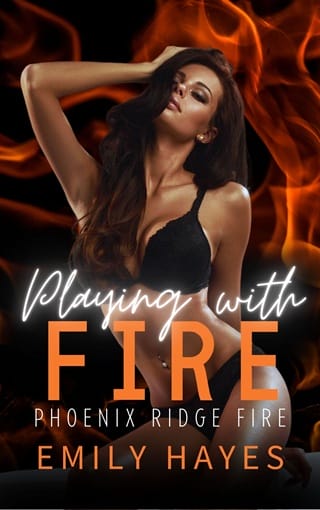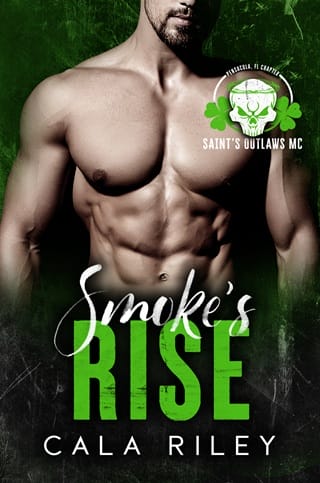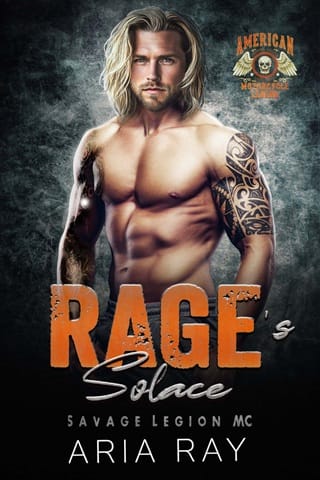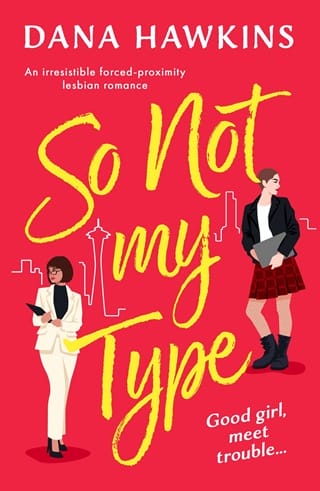Chapter 2
Chapter Two
I am going to see Charles Dickens. Right now. I am walking along crowded George Street, heading to the Assembly Rooms music hall to see the Charles Dickens. When I was in elementary school, my parents snagged tickets to see the Spice Girls, and as happy as I’d been then, I think I’m even more excited now.
My dad is an English prof. I grew up on Dickens. Landing in an era where he’s still alive and writing? I’d hardly been able to fathom it.
Many of my favorite classic novelists are still alive in this time. George Eliot. Wilkie Collins. Mary Elizabeth Braddon. I won’t have much chance of seeing them—they’re busy doing writerly things—but Charles Dickens tours. Or he did. He’s now on his farewell circuit. He’d been due to stop in Edinburgh in February, but by the time Isla heard of it, she wasn’t able to get tickets. That stop had to be rescheduled, though, because he injured his foot, which had caused such an outcry that the newspaper had to print his doctor’s note to prove it.
The stop was rescheduled for late December, and that’s how Gray obtained tickets for the last performance. Because, while Christmas might not be celebrated in Scotland, some of the wealthy travel to England for the festivities, and he snagged four tickets from an acquaintance who could no longer attend.
Isla and I get two of those tickets. Gray is accompanying us, along with his best friend, Detective Hugh McCreadie.
The music hall is only about a quarter mile from Gray’s Robert Street town house, so we are walking. To be honest, we walk most places. I won’t say that Victorian Edinburgh is a particularly pleasant place to stroll, given the amount of excrement, not all of it from horses. Add in the amount of precipitation, and you can’t even avoid that excrement, because it melts into every puddle. But boots come clean, and these days, I don’t even need to scrub them myself. Coach travel might be cleaner, but we can usually get where we want to go faster on foot. Also, being late December, the precipitation is all snow, which blankets the soot-covered city in white and also freezes the puddles, bodily waste and all.
The music hall, like Gray’s town house, is in the New Town. Initially, that’s where the wealthy moved to escape the poverty of the Old Town. These days, it’s home to both the upper class and the upper-middle, like the Gray family.
We are dressed for a night on the town. Gray wears a silk top hat and a long coat over a black wool three-piece suit with a starched white shirt and silk cravat. McCreadie is, as always, more stylish, with his checked jacket slightly shorter and more fitted, as is the incoming style. Isla has moved far enough from mourning that she’s able to wear lilac, and her dress is divine, with silver buttons and silver-gray pinstriping plus wider strips of silver-gray along the bottom of the sleeves and skirts. My own dress is the same one I wore to a party last month: turquoise silk with rust-brown embroidery and beadwork, and rust-brown lace trim.
To accommodate the narrow walking path, McCreadie and Isla are ahead of us. Isla has only to slip, one boot barely sliding, before McCreadie has his elbow out for her to take. It’s chivalrous, but also an excuse to have Isla on his arm, one she happily accepts. Just as I happily accept Gray’s arm when he notices them and puts out his arm for me. It’s an old-fashioned way of walking, the man with his elbow extended, the woman holding it. Very Victorian. Also, a welcome bit of human contact in a world where that is just not done.
In this era, physical intimacy is for couples and, even then, only in the bedroom. Hugs between friends are not a thing, and I find myself missing that and cherishing the moments where I have an excuse to do something like hold Gray’s arm.
As we near the theater, we need to merge into a stream of fellow attendees. Though everyone is dressed in their finest, not all of it comes from New Town shops. There are plenty of second- and even third-hand dresses and suits. It’s appropriate that a Dickens reading should be accessible to the working class. It would be even better if it were accessible to the poor , but that’s too much to hope for. Gray said that the stalls are priced at five shillings, which my math skills tell me is about thirty dollars in my own world.
As we draw near the music hall, the jabbering of voices whisks me back to sporting events in Vancouver. It sounds like resellers offering overpriced tickets to a sold-out game, but as I draw close, I realize it’s actually the other way around. People are banging on the ticket booth, offering to pay as much as five pounds for those cheap seats, as if the venue might be hiding some in reserve. I also notice that no one is stepping forward to sell their tickets for that price.
The commotion, however, means we need to slow with the desperate would-be buyers partly blocking the entrance. McCreadie grumbles about that.
“Someone should have had a few officers assigned for crowd control,” I murmur to him. “Pity we don’t know anyone who could help them out now.”
“Be my guest,” McCreadie says. “If I take on that lot, I won’t be seeing the performance.”
“And so you will not interfere,” Isla says, tightening her grip on his arm.
“I will not,” he says. “I can still grumble, though.”
Slowing means we’re stuck standing outside. Being stuck standing outside means people start gawking around the queue. Gazes swing to Gray. That’s understandable. He’s just over six feet, with broad shoulders and striking—if severe—features. Admittedly, McCreadie is better looking, remarkably handsome even with fashionably thick whiskers. Yet the gazes fall on Gray, and it’s not his height that does it. It’s his brown skin. He might have been raised by Frances Gray, but his mother was Irvine Gray’s mistress, and obviously a woman of color, though Irvine took any details to his grave.
We’re in the days of the British Empire, when travel and immigration is easier, if not exactly easy. I can look down the queue and see several people of color. Most, however, are clearly working class. The one young Black woman in a fashionable gown accompanies an older white woman in a manner that suggests she’s a companion or lady’s maid. I have to crane my neck and squint to see any person of color who looks middle class.
What gets people’s attention isn’t that Gray is a person of color; it’s that he dresses as if he’s wealthy enough to have a tailor, which he does. Admittedly, sometimes they also look because he hasn’t bothered to change out of a shirt spattered in blood, but that’s thankfully not the case today. These days, though, there’s another reason people gawk, and that’s what I’m on the watch for.
A few months ago, someone started chronicling Gray’s adventures in crime solving. Those adventures may have coincided with him taking on a certain assistant, but I’m still blaming poor McCreadie. Between the three of us—and Isla, when a case interests her—we’ve solved a few murders. The person who interested that writer, though, was Gray. Well, Gray and his pretty assistant, but my role in the stories seems mostly window dressing.
The Mysterious Adventures of the Gray Doctor has recently changed writers and—thankfully—titles. The previous author has been shut down, by methods known only to the new author, who granted Isla a cut plus editorial oversight. There was no way of getting rid of the stories altogether, so taking control of the narrative was our best bet. For now, they’re a niche publication, mostly appealing to mothers and their children. Why are women and children the primary market for tales of murder and mayhem? Because these are Victorians.
Tonight, while I do see one mother and her children gesturing at us and whispering, they don’t approach, so we can pretend all is well and we are safe in our bubble of anonymity.
Soon we’re inside the music hall. Our tickets are for the balcony. In the modern world, I like seats in the orchestra, where I can truly appreciate live performances. Here, the orchestra seats are the stalls, which are for those who can’t afford better. My disappointment evaporates when I see those stalls. Most of the seats are on church-like pews, with hundreds of people jammed into an area that defies any sort of safety code. One scream of “Fire!” and dozens would be trampled. I decide I’m fine with the balcony.
We aren’t in actual balconies, either. More like having seats in concert stands. McCreadie goes down the aisle first, followed by Isla, followed by me and then Gray. While Isla and I would have chosen to sit beside each other anyway, this arrangement is natural for the time period—the men flanking the women so they don’t need to sit beside strangers who might be male.
We settle in, and we all remove our hats, which is expected and even mentioned on the tickets. As we wait, Isla and I discuss Dickens’s latest work, No Thoroughfare , which he wrote in collaboration with Wilkie Collins. Isla has seen the show. I have not, though I read the novel form in the twenty-first century.
“I hear he is working on a new book,” Isla says. “I am hoping he will discuss it tonight.” She wags her finger at me. “And no spoilers from you.”
Which novel would that be? Admittedly, I’m not great with dates. I know Dickens’s work but not the order or years of publication. I think back to the library at the town house. Which book is missing? I’m still working through that when someone steps on the stage to announce the main event.
The music hall venue is appropriate, because this feels much more like a concert than an author reading. I can’t hear what the MC is saying, as people keep chattering and others keep shushing them, often louder than the actual talkers. Finally, I catch the tail end of the MC’s speech.
“—will begin with a seasonal reading of A Christmas Carol .”
I look at Gray and arch one brow, and there must be accusation in my eyes because he leans over and whispers, “The poor man will be hanged for certain now. Such a loss to the literary world.”
It’s the week after Christmas, and while there were some shop and house decorations, overall, it was far less than I’d expected. I know from my father that the Victorian era was the time when Christmas was still becoming the spectacle it is in the modern world. Credit—blame?—for that can be laid, at least in part, at the feet of the man about to mount the stage and the story he is about to read.
In North America, a secular Christmas revolves around the family, especially children. You get together with your nearest and dearest, and you make a magical day for the little ones in your life. You also share your bounty with the less fortunate—’tis the season to be charitable. All that comes from A Christmas Carol , which refocused a community-based celebration on the family, especially the children, as well as shining a spotlight on the plight of the poor and the obligations of the wealthy.
Isla had asked whether there was any particular part of Christmas I longed to celebrate. I said no, Hogmanay would do the trick well enough, but I did wake to a plate of sugarplums on Christmas morning. May I also say that, like Turkish delight, sugarplums are not at all what I expected? There’s no actual plum involved. It’s more like a jawbreaker, with a seed at the center and then layers of sugar. Disappointing, but not nearly on the scale of the Turkish delight debacle. I swear I can still taste the cloying rosewater from that .
On the stage, the MC is walking away, and I realize the man standing there now...
It’s Charles Dickens.
This is the Dickens I know from photos, mostly taken in this era, showing a man with kind eyes, balding hair, and a somewhat unkempt long beard. In those photographs, though, he’s always dead somber, and that is not the man I see before me. He is smiling and animated and moves spryly to center stage.
As Dickens begins, I ease back in my seat, prepared for a relaxing literary performance. I’ve attended readings of A Christmas Carol before. I even participated in a group reading for one of my dad’s university classes. Being the only child among the actors, you can guess who I played. God bless us every one.
Although that had been a reading rather than a dramatization, I’d treated it like a full-blown performance, limping around the stage and looking pathetic but hopeful as only Tiny Tim can. I had, in short, hammed it up... and as Dickens begins to read on stage, I realize I might have underplayed it.
When Isla said it would be a two-hour performance, I’d been confused. I’ve been to author readings. The best are short and sweet. Even the longest top out at thirty minutes, which let me tell you, is a long time to be actively listening to someone who is not an actor or a public speaker. No matter how interesting the material, most authors are not meant to read their work.
Dickens is an exception. Possibly because, at one time, he’d entertained thoughts of acting as a career path. As I watch, I’m honestly not sure what I think. My preconceptions are smashed to such splinters that I can only sit there and gape.
In my time, Dickens is classic literature. I know that was very different during his own life. He was considered a populist writer, with all the scorn that can bring. His appeal went far beyond the educated upper—or even middle—class. He told stories about the poor and working classes. Real Victorian life, the sort I see every time I visit the Old Town.
Yet as much as I understood his broad class appeal, I couldn’t help but still stick him in the “classic author” box, alongside the other literary greats. Which means I am in no way prepared for what I am witnessing.
This is Dickens’s final tour because the performances are getting to be too much for him, physically. Yet the man I see is in his fifties and hardly doddering. The reason these performances exhaust him? Because they’re actual performances.
I am treated—if that’s the word—to the most gonzo reading of A Christmas Carol ever. It’s as if seven-year-old Mallory got to play all the parts and played her little unselfconscious heart out. Except the guy doing the performance is Charles Dickens himself.
“What do you think?” Isla whispers. “Are readings like this in your day?”
I try to imagine Margaret Atwood getting up on stage and doing this sort of “reading” from The Handmaid’s Tale .
Nope.
I can’t imagine even the most populist authors of my time giving a performance like this.
And this is Charles freaking Dickens.
“He’s very... energetic,” I say.
“Isn’t he? They say his readings bring him more income than his books do.”
“I... can imagine.”
As I watch, I am reminded again how much this world is not what I expected. When I silence my preconceptions, I begin to enjoy it, rather than staring like an elderly aunt at her first rave.
Dickens finishes his reading from A Christmas Carol . Then it’s on to Oliver Twist . Good choice. Definitely a crowd-pleaser. I’m wondering what scene he’ll read when?—
It’s the Nancy and Sikes scene. The brutal murder of Nancy at the hands of her boyfriend, Bill Sikes. I glance around nervously. This is an all-ages crowd, and he’s reading what might be the most violent scene of his career. And everyone in the music hall—from children to well-dressed ladies—hangs on his every word.
“This is...” I manage to choke out, “an interesting choice.”
“He always reads this one,” Isla says. “The crowd would rise up in protest if he did not.”
I sit there, watching a packed theater of prim Victorians devouring Charles Dickens’s reading of a gruesome and tragic murder scene.
“At least a dozen women will faint,” Isla whispers. “Loudly and enthusiastically.”
I stare at her. Then I stare at the bloodthirsty crowd of ladies and gentlemen, all of them dressed in infinite layers as protection against the horror and shame of revealing a stray bit of bare skin.
I will never understand Victorians.
“Not what you expected?” Gray whispers at my ear.
I turn and gesticulate, unable to put my thoughts into words. His lips curve in a smile that grows until he needs to cough in his hand, politely, before he laughs aloud. Then I settle in to watch the reading... while Gray settles in for, I suspect, the even more entertaining spectacle of watching me watching the reading.
 Fullepub
Fullepub 